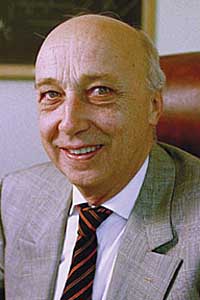Brice Bosnich facts for kids
Quick facts for kids
Brice Bosnich
|
|
|---|---|
 |
|
| Born | 3 June 1936 |
| Died | 13 April 2015 (aged 78) |
| Other names | Boz |
| Scientific career | |
| Thesis | Substitution at an octahedral metal centre (1962) |
| Doctoral advisor | Francis Patrick Dwyer |
Brice Michael Bosnich FRS (born 3 June 1936 – died 13 April 2015) was an Australian chemist. He was known for designing special chemical structures called ligands. These ligands are very useful in a process called homogeneous catalysis. This process helps make chemical reactions happen faster and more efficiently.
Contents
Becoming a Scientist
Brice Bosnich studied at the University of Sydney. He earned his Bachelor of Science degree in 1958. Later, he went to the Australian National University (ANU). There, he completed his PhD in 1962. His teacher and mentor was Francis Patrick Dwyer, a famous chemist. Another well-known chemist, Alan Sargeson, was also studying there at the same time.
His Work and Discoveries
After finishing his studies at ANU, Brice Bosnich started teaching. He taught at University College London for a while. Then, he moved to Canada and worked at the University of Toronto from 1970 to 1987.
Later, he became a special professor at the University of Chicago in the United States. Even after he retired, he continued his research. He returned to his old university, the Australian National University, as a visiting researcher.
Designing Special Ligands
While at the University of Toronto, Bosnich made a big breakthrough. He found a smart way to create chiral diphosphine ligands. Think of chiral as meaning something has a "handedness," like your left and right hands are mirror images but can't be perfectly placed on top of each other.
His most famous ligand was named chiraphos. What made chiraphos special was that its handedness came from its main structure, not just from parts attached to it. This idea was very important. It helped other scientists create many similar ligands. These new ligands are used in a process called asymmetric hydrogenation. This process is key for making specific types of molecules, often used in medicines.
Other Research Areas
Brice Bosnich also explored other interesting areas in chemistry. He studied hydroacylation catalysis, which is another way to speed up chemical reactions. He also worked on creating ligands that could copy the special properties of certain proteins. These proteins are called blue copper proteins because they contain copper and are often blue.
Awards and Recognition
In 2000, Brice Bosnich was honored for his important work. He was chosen to be a Fellow of the Royal Society (FRS). This is a very high honor for scientists in the United Kingdom.
His biography from the Royal Society highlights his achievements:
Bosnich made many important contributions to inorganic and organometallic chemistry. A central theme of much of his research had been the stereochemistry of inorganic and organometallic complexes and of reactions mediated by such complexes. His design, synthesis and studies of the ligands, chiraphos and prophos, represent a major accomplishment and have contributed enormously to our understanding of the mechanisms of chiral recognition and asymmetric catalysis. Before his death, his research interests expanded to encompass the mechanistic aspects of a wide range of reactions, including allylic alkylations, metal catalysed Claisen rearrangements, hydroacylation and hydrosilation, as well as cooperative phenomena in binuclear metal complexes.
In simpler terms, this means he greatly advanced our understanding of how chemical reactions work. Especially, he helped us understand how to control the "handedness" of molecules. His work on ligands like chiraphos was a huge step forward. It helped scientists create new ways to make specific chemical compounds. His research also covered many other types of reactions and how different metal complexes work together.

